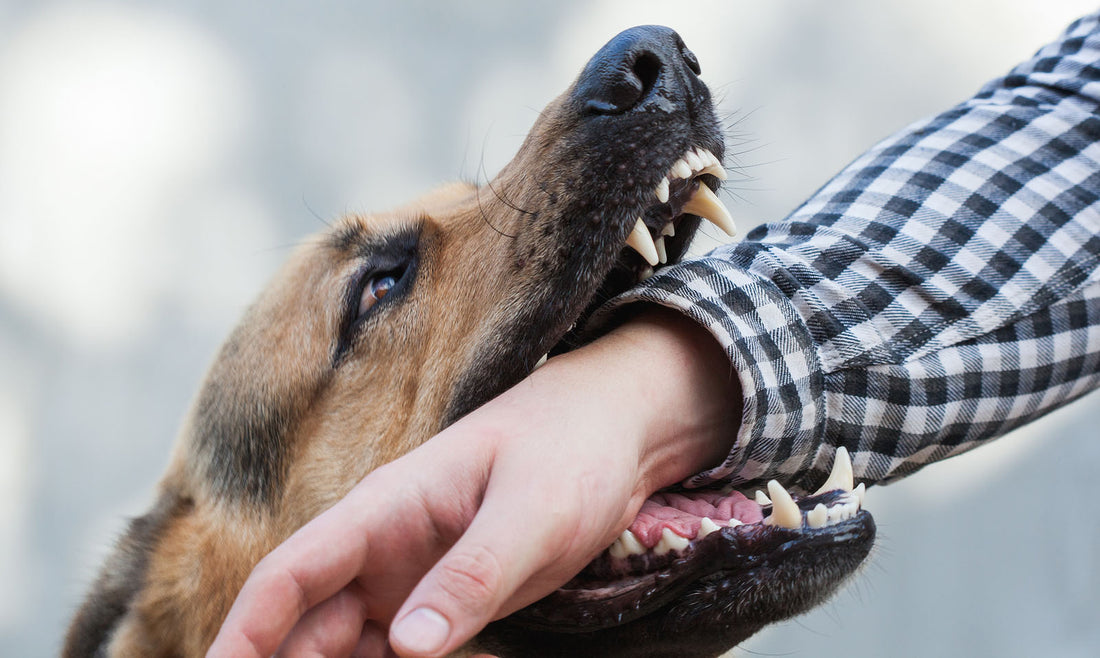
How to Stop a Puppy from Biting: 5 Important Tips
Here’s a common scenario.
You’re playing with your new puppy and he jumps up in your lap, as excited as can be. You’re petting him, his tail is wagging, everything is idyllic.
Then, he chomps down. You pull your hand away and say “No”, but those fingers are just too fascinating. Now, you can’t keep him away. Whenever you try to pet him or do anything, he’s trying to pretend your hand is a chew toy.
Or, here’s another one.
You walk through the kitchen, your adoring puppy at your heels, then suddenly, you feel those tiny needle teeth on your ankle. You try to pick her up, only to find those teeth now turning your poor hand into a pincushion.
Sound familiar?
Puppy biting behavior can be cute at first, but it gets old fast, and frustrates many puppy parents.
In this article, we’re going to discuss why puppies bite, to what degree to expect it, and when to know if it’s becoming a true behavioral problem. We’ll also make sure to cover tips to train your puppy out of this behavior.

Why Do Puppies Bite?
Most of the time, biting behavior in puppies is very normal, because it’s how they play. Even if you look at a litter of puppies only a couple weeks old, you can see the pups mouthing and playfully biting each other.
Naturally, when she becomes a part of your family, your pup will identify you as a playmate and exhibit the same behavior.
It’s also very natural for puppies to explore their environment using their mouth. Similar to a human toddler, puppies will put things in their mouth to see if something is edible. Puppies also experiment with different biting pressures to see what kind of reaction they get and learn if this is acceptable or not.
Is Biting Behavior Normal?
For the most part, in a young puppy, yes it is. Problems we can run into though, include allowing it to persist beyond puppyhood, encouraging the behavior, and inadvertently developing other types of abnormal biting behavior, like fear biting.
While it is normal for puppies to bite and be mouthy when playing with each other, they also learn boundaries. If one puppy bites another too hard, the other puppy will cry. This usually leads the biting puppy to stop, reassess the situation, and try again at playing, perhaps more gently.
It’s especially true if you put a puppy together with an older and more experienced dog, for the older dog to set clear boundaries if the puppy’s play behavior goes over the top.
But if we don’t have other dogs in the home, it’s important for us to set those boundaries. Naturally, we don’t want to see overenthusiastic play biting behavior still present in a one year old dog who now has adult teeth and considerably stronger jaws.
When is it Too Much? How Do I Know?
Learning the limits and teaching those limits to your pup are very important. Similar to the way our human children can get carried away, not listen to directions, and sometimes get hurt (or hurt us accidentally), puppies can also get carried away with biting and play behavior.
During play, your puppy should still be willing to stop, obey a simple command, and focus on you, if you’ve been working on these basic aspects of training already. But if your young pup typically obeys some simple, basic commands and usually is very attentive to you, and you find that during play he is unable or unwilling to stop and listen, and continues to growl, bite, and zoom around, he’s probably overstimulated and needs a time-out.
Biting behavior should also be dissipating with age. By 4-6 months, you really should have a much better trained pup who is willing to listen and follow directions. If you find that you still have little control over this behavior and your pup still tries to bite hands, feet, and ankles of yourself or anyone else in the home, you need to focus on serious training if you haven’t already, or seek outside help.
Tips to Prevent Puppy Biting Behavior
So, now with some background, let's get down to it. How to stop a puppy from biting.
We should be working on biting behavior from the earliest age, just like any other focus of training. Our main goals in working on biting behavior are to decrease the frequency, decrease the pressure or intensity of biting (i.e. training your pup to be gentle), and to avoid or correct situations where we may be encouraging inappropriate biting behaviors.
Tip #1: Bite Inhibition
Bite inhibition is about both reducing the frequency of biting behavior as well as encouraging a puppy to be more gentle when she does use her mouth to play. There are a couple of ways we can do this.
If your puppy is playfully biting and mouthing on your hand and bites down too hard, vocalize loudly by saying “Ouch!”. In this way, you’re imitating what a dog might do by yelping if another dog bites too hard.
Make sure to be loud. Some folks aren’t loud enough. Make sure not to sound so much angry as surprised. And avoid using the term “No” if possible. It’s important to reserve “No” for bad behaviors, like going potty in the house. Play biting isn’t a bad behavior, it’s a normal one. Just one that we need to bring down to an acceptable level.
This tip will generally only work if your puppy is at a lower level of stimulation and is open to taking commands. If your pup is over-excited and really wound up, there’s another tip we’ll get to that is more effective.
After saying “Ouch!” loudly, it can be important to stop play and ignore your puppy for a couple of minutes. This sends the message that certain behavior will result in the end of play. But make sure to come back after a couple minutes and resume play again.
Eventually with this technique, your puppy should learn to not only bite less frequently, but also to be more gentle when something is in his mouth. Pups that learn this are more likely to even be more gentle when biting out of fear or surprise.
Tip #2: Redirection
The goal of redirection is to take a puppy’s focus from your hand or pantleg, and shift it to something more appropriate, like a toy or treat. But make sure to only use treat rewards if the pup is doing something you want her to do. If you give her a treat while she’s biting you in the hope this will get her to stop, she may take this as accepting a reward for her biting behavior and be encouraged to do it more. This can get confusing, so allow me to explain.
If your pup bites your hand, still make sure to vocalize loudly with “Ouch!”. Then introduce an approved toy instead. If she accepts the toy, you can praise her and provide her with a treat. If she ignores the toy and continues for your hand, then it’s important to follow the advice of Tip #1 and take a short break.
It can also be helpful with any undesirable behavior, to introduce a command to break the pup’s fixation on it, convert that attention to you, and when he obeys the command, provide a treat reward. For example, if your pup is getting carried away with zooming, biting, etc., tell him to “sit” and “stay”. If he follows your directions and chills out, provide a treat. Naturally, if he does not do as you ask, don’t provide a treat--he might be overstimulated and need a time-out.
For another example, let’s say your pup is biting and chewing at your ankles, especially while walking. Take a small training treat and hold it next to you as you walk, just out of reach. You can concurrently state a command over and over like “walk”, “follow”, or “heel”. Have her follow the treat for several paces, then stop and have her sit. If she follows your directions, let her have the treat.
If she resumes pant-leg biting, repeat this process. While you may have to simply take a time-out break from time to time, you should hopefully notice that your pup listens to you more and will learn to walk more calmly and appropriately with you.
Tip #3: Provide Play Opportunities with Other Pups
If you don’t have another pup in the home, especially an older dog, seek out some opportunities for socialization while your puppy is still very young.
Some pup parents get very concerned about exposing their puppy to other dogs at too young an age for health reasons because vaccines aren’t even close to being completed. While physical health is very important, behavioral health is just as important and the period before a puppy turns six months is crucial for learning appropriate social behaviors.
While it’s not a good idea to take your puppy to the dog park at 8 weeks of age and let her run around with unfamiliar dogs, it is okay to provide social visits with select pups who are healthy, friendly, and tolerant. If you set up a meeting with other puppies of a similar age, make sure the other puppies are up to date on vaccination, deworming, and are showing no signs of illness.
Providing these social opportunities help a puppy learn social boundaries from other dogs, especially if this is an older, more experienced dog. Taking the example of human children again, for those that have them, think about putting two toddlers together. They’re likely to have fun, but will probably just feed off each other until one of them gets hurt.
But consider pairing a toddler up with a child who is a few years older, and who is also calmer and well-behaved. The toddler may be far more willing to play nicely and will look to emulate the older child.
This can also be the difference for a young puppy too. Put her with another puppy the same age and sure, they’ll have fun. But they’re less likely to learn good social cues because neither actually knows them yet. Put a puppy with a calm, well-behaved older dog, and you’re more likely to see a pup emulate the older dog. The older dog is also more likely to give signals when too much is too much.
Tip #4: Use a Crate or Pen for Short Time-Outs
This tip is important when your puppy is not at a low level of stimulation and is not listening well to directions. This can especially be the situation with an evening case of the “zoomies” where a puppy is running around, biting everything in sight, and is clearly overstimulated. Any attempt to say “Ouch!” only makes the pup even more excited.
If this happens, try to stay calm and don’t use scolding or negative behavior. Pick up your puppy and tell her it’s “time for a time out”. Then place her in her crate or playpen. Make sure to tell her she’s a good girl and that we just need to calm down a little.
It’s very important that this not come across as a punishment. We don’t want to associate the crate or playpen as a place for punishment, but the reality is that there may be no other way to get her to calm down. Try to be firm, but make it positive.
When she calms down, which might take just 5 minutes, or could take 15 minutes, have her sit, give her a treat, and then let her back out to resume play.
Tip #5: Avoid Situations Where a Puppy Gets Frustrated or Fearful
Just like it’s very important to provide positive experiences and productive socialization opportunities, it’s just as equally important to avoid situations where a puppy may develop negative behaviors.
One negative situation that can perpetuate biting behavior is when a puppy becomes frustrated during play. Teasing with a toy, or playing tug and never allowing a puppy to have the toy can lead to pent up frustration that may lead to a burst of biting to try to get a toy. If this is then met with scolding for the biting behavior, this leads to significant negative behavior development.
It’s important to recognize when a puppy is getting frustrated and to either modify what’s happening or discontinue the activity. This is especially true in homes with young children, so any play between a young child and a puppy must be closely supervised. Children may think it’s funny to play tug and always come out the victor, but this will only lead to frustration on the puppy’s part.
Similarly, any rough play with teasing or hitting with soft toys needs to be discouraged. This will only promote fear and frustration on the puppy’s part. If the puppy bites either out of frustration or because she’s scared, the child is likely to stop. This may only reinforce the belief on the puppy’s part that if she’s scared or frustrated that biting will provide results.
Some of this may apply to adults, especially during a good game of tug, but most of these situations involve children, so always make sure to teach kids to be gentle and to let their puppy pal have the toy for a bit as a reward for good play.

Is This Play Biting or Aggression?
To a trained eye, play biting is easy to recognize and differentiate from other biting behaviors. But new puppy parents especially may not be able to recognize the difference.
To understand if biting is just from play or may be a sign of a separate developing behavior, make sure to take an assessment of the environment in which the biting is happening, as well as other physical cues from your pup.
For example, if your puppy bites your after a really intense game of tug or throwing a toy around and he looks like he’s ready for more, the bite is probably an accident from overstimulation and he just got carried away. He should otherwise appear happy, with his tail and ears up, and a calm but excited presence to his face and eyes. We naturally shouldn’t see any baring of teeth.
But now take a different situation. Let’s say you just put your dog’s food down and she immediately growls and snaps at your hand. She’s looking at you sideways, her tail is straight back and she appears very tense. This is what food aggression can look like and is something that needs to be addressed with professional help immediately. But the difference here from the first scenario is that there is no play involved, and your pup’s body signals are completely different.
And here’s a third scenario. Let’s say you make an attempt to trim your dog’s nails. As soon as you get the trimmers out, he runs to hide under the dining room table. When you reach for him, he snaps at you. His tail is tucked between his legs, his ears are down, his body is tense, and his eyes have a very worried look. This is fear aggression. Possibly, a previous negative experience with the last nail trim precipitated it. But again, there’s no play involved here, and his body signals are much different than the first scenario.
It can be hard to tell when two dogs are playing and some growling and snapping ensues, if this is normal play behavior or if intervention is needed. Some simple questions to ask include: “Have these two dogs played together before?” and “Is this how they usually play?” Another way to tell is based on body cues. Do these dogs appear tense, is the hair on their backs and tails standing up?
Growling can occur during play behavior, but usually, it develops during the course of play while two dogs are being mouthy with each other. If growling occurs either at the beginning of an interaction with another dog, or if a dog is growling and appears to be trying to keep his distance, this is not playful growling. In these cases, growling is either aggressive or being used as a warning to please stay away.
If you ever see an unfamiliar dog approach you or your dog and display any kind of tensing, side-eye staring, or low growling, this dog is unlikely to be friendly and you need to remove both yourself and your dog from that situation. This also highlights the importance of leash laws. If your dog encounters an unfriendly dog and either dog is not on a leash and they can’t be pulled away from each other, this leads to significant safety concerns for all involved.
When to Seek Professional Help
It’s okay to seek help from your veterinarian or a trainer if you ever feel overwhelmed with your new puppy’s behavior, especially if you’ve been working on focused training techniques as outlined in this article and you don’t seem to be making progress.
Between 6 months to 1 year of age, many behaviors a pup has learned become set in stone permanently and are extremely hard to “unlearn”. My rule is that if you’re approaching 5-6 months of age and you still have a pup that is exhibiting unwanted biting behavior, even play biting, you need to seek outside help.
The first place to start is talking to your veterinarian. He or she may have some additional tips you haven’t thought of. But, more importantly, most veterinarians have a trainer they can recommend to you.
If you’re seeing any kind of biting behavior other than overenthusiastic play biting, your veterinarian may instead recommend that you see a board certified veterinary behaviorist. This is a veterinarian who has completed residency training specifically in behavior and has passed competency exams to be allowed to practice this specialty. Many trainers may not feel comfortable getting involved with aggressive biting situations and more often these are referred to a veterinary behaviorist.
It is important to remember that if you adopt an older dog, even one that just turned a year of age, that she may come with poorly corrected behaviors you may need to work on intently. Unfortunately, many young dogs relinquished to shelters or rescue groups are given up because of behavioral problems that were not addressed early on.
While it can be difficult to correct behaviors after a dog turns a year, it’s not impossible. But make sure you and your family are prepared for this responsibility and are open to seeking professional help early if the responsibility is more than you expected.
I see very few cases, fortunately, where biting behavior has persisted beyond 6-7 months of age. And in most of those cases, I find that the tips we just discussed haven’t been employed consistently.
So rest assured, most biting behavior in young puppies is normal and that with the right degree of focused basic training and patience, this behavior can be corrected, or at least modified to an acceptable level that allows for a good continued bond with your pup.







